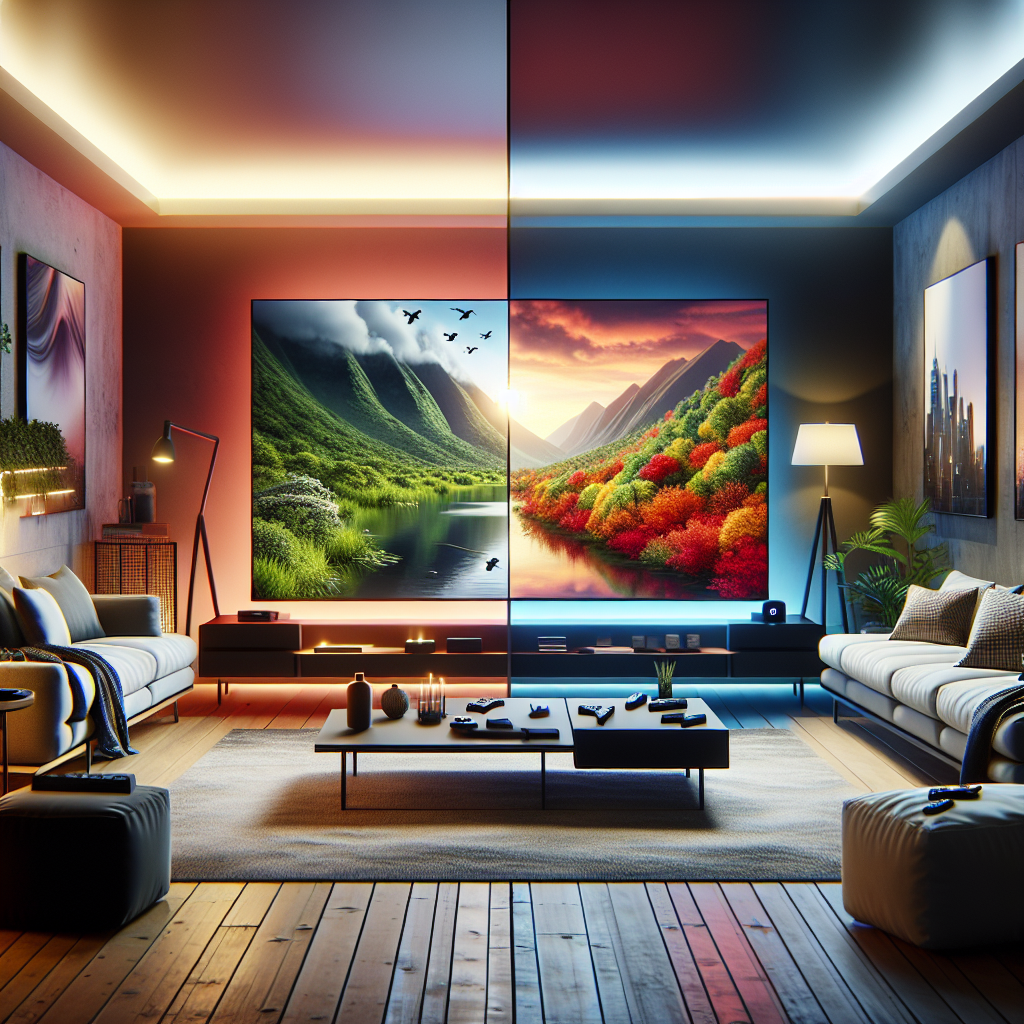Choosing the perfect TV for your home can be daunting, especially with so many options available. Among the myriad of choices, ULED and QLED TVs have risen to prominence, each offering unique features and benefits. For tech enthusiasts, home entertainment lovers, and gamers alike, understanding the differences between these two technologies can help make an informed decision. In this blog post, we’ll explore the intricacies of ULED and QLED, and provide insights to guide you in choosing the right TV for your home.
What is ULED?
An Introduction to ULED Technology
ULED, or Ultra Light-Emitting Diode, is a term coined by Hisense to describe its line of premium LED TVs. While it may sound like a new type of display technology, ULED is actually an enhanced LED TV that incorporates various proprietary technologies to improve picture quality. These enhancements include local dimming, wide color gamut, high dynamic range (HDR), and smooth motion. The goal is to deliver a superior viewing experience compared to standard LED TVs.
The Benefits of ULED
ULED TVs offer several advantages, particularly in terms of picture quality. The local dimming feature allows for deeper blacks and improved contrast, making images look more vibrant and lifelike. The wide color gamut ensures a broader range of colors, resulting in richer and more accurate color representation. HDR enhances the overall dynamic range of the image, providing more detail in both the shadows and highlights. Lastly, the smooth motion feature reduces motion blur, making fast-paced action scenes and sports more enjoyable.
Ideal Uses for ULED
ULED TVs are versatile and suitable for a variety of uses. They cater to home entertainment enthusiasts who appreciate high-quality visuals when watching movies or TV shows. Gamers will also appreciate the smooth motion and vibrant colors, which enhance the overall gaming experience. Additionally, ULED TVs are a great choice for sports fans who want to enjoy live events with crisp and clear images.
What is QLED?
An Introduction to QLED Technology
QLED, or Quantum Dot Light-Emitting Diode, is a display technology developed by Samsung. QLED TVs use quantum dots, which are tiny semiconductor particles that emit light, to enhance color and brightness. These quantum dots are placed on the LED backlight, allowing them to emit precise colors and improve overall picture quality. QLED technology is known for its impressive color accuracy, brightness, and longevity.
The Benefits of QLED
QLED TVs are renowned for their exceptional color accuracy and brightness levels. The quantum dots allow for a wider color spectrum, resulting in more vibrant and true-to-life colors. Additionally, QLED TVs can achieve higher brightness levels compared to other display technologies, making them ideal for bright rooms or environments with a lot of natural light. The quantum dot technology also contributes to the longevity of the display, ensuring consistent performance over time.
Ideal Uses for QLED
QLED TVs are perfect for those who prioritize color accuracy and brightness in their viewing experience. They are particularly well-suited for home entertainment systems in rooms with ample natural light, as the higher brightness levels help maintain image clarity. Gamers will find QLED TVs appealing due to their vivid colors and fast response times, which enhance gameplay. Additionally, QLED TVs are great for sports enthusiasts who enjoy watching live events with vibrant and realistic visuals.
Picture Quality Comparison
Color Accuracy and Vibrancy
Both ULED and QLED TVs offer impressive color accuracy and vibrancy, but they achieve it through different means. ULED TVs use wide color gamut technology to enhance color representation, while QLED TVs rely on quantum dots for precise color emission. While both technologies deliver excellent color performance, QLED TVs tend to have an edge in terms of color accuracy and vibrancy, thanks to the quantum dots.
Brightness and Contrast
When it comes to brightness and contrast, QLED TVs generally outperform ULED TVs. The quantum dot technology enables QLED TVs to achieve higher brightness levels, making them suitable for well-lit environments. However, ULED TVs excel in contrast, thanks to their local dimming feature. This allows ULED TVs to produce deeper blacks and better contrast ratios, which can enhance the overall viewing experience, especially in darker settings.
HDR Performance
High dynamic range (HDR) is a crucial feature for modern TVs, as it enhances the overall dynamic range of the image. ULED TVs offer HDR support, which improves detail in both shadows and highlights. QLED TVs also support HDR, and their higher brightness levels give them an advantage in showcasing HDR content. Both technologies provide excellent HDR performance, but QLED TVs may offer a slightly better experience due to their brightness capabilities.
Design and Build Quality
Sleek and Modern Designs
Both ULED and QLED TVs boast sleek and modern designs, making them attractive additions to any home entertainment setup. ULED TVs typically feature slim bezels and elegant stands, while QLED TVs often come with stylish frames and minimalist aesthetics. The choice between the two often comes down to personal preference and the specific design elements that appeal to individual tastes.
Durability and Longevity
Both ULED and QLED TVs are designed to be durable and long-lasting in terms of build quality. QLED TVs have an advantage in terms of longevity, thanks to the quantum dot technology used in their displays. Quantum dots are known for their stability and resistance to degradation, ensuring consistent performance over time. ULED TVs are also built to last, with robust construction and high-quality materials.
Installation and Setup
Setting up a ULED or QLED TV is generally straightforward, with both types offering easy installation and setup processes. Most models come with user-friendly interfaces and intuitive menus, allowing users to quickly configure their settings. Additionally, both ULED and QLED TVs are compatible with various mounting options, providing flexibility in terms of placement and positioning.
Gaming Experience
Response Times and Input Lag
For gamers, response times and input lag are critical factors in choosing a TV. Both ULED and QLED TVs offer relatively low input lag and fast response times, making them suitable for gaming. However, QLED TVs may have a slight advantage in this area due to their advanced processing capabilities. This can result in smoother gameplay and a more immersive gaming experience.
Graphics and Visuals
In terms of graphics and visuals, both ULED and QLED TVs deliver stunning performance. ULED TVs provide vibrant colors and excellent contrast, enhancing the overall visual experience. QLED TVs, with their superior color accuracy and brightness levels, offer an even more impressive display of graphics. Gamers who prioritize visuals may lean towards QLED TVs for the most lifelike and immersive experience.
Compatibility with Gaming Consoles
Both ULED and QLED TVs are compatible with the latest gaming consoles, such as the PlayStation 5 and Xbox Series X. They offer support for advanced gaming features, including HDR, variable refresh rate (VRR), and auto low latency mode (ALLM). These features contribute to a seamless and responsive gaming experience, making both ULED and QLED TVs excellent choices for gamers.
Price and Value
Price Range of ULED and QLED
When considering a new TV, price is often a significant factor. ULED TVs are generally more affordable than QLED TVs, making them an attractive option for budget-conscious consumers. QLED TVs, on the other hand, tend to be positioned as premium products, with a higher price tag reflecting their advanced technology and superior performance.
Cost-Effectiveness
While QLED TVs may have a higher upfront cost, they offer long-term value through their exceptional picture quality and durability. For those who prioritize performance and longevity, the investment in a QLED TV can be worthwhile. ULED TVs provide excellent value for money, delivering impressive picture quality and features at a more accessible price point.
Making the Right Choice
Ultimately, the choice between ULED and QLED TVs depends on individual preferences and priorities. ULED TVs offer a cost-effective solution with great picture quality and features, while QLED TVs provide the best possible performance and color accuracy. Consider your specific needs, budget, and viewing preferences when making your decision to ensure you select the perfect TV for your home.
Conclusion
In the battle between ULED vs QLED, both technologies offer impressive performance and features that cater to different needs and preferences. ULED TVs provide excellent value for money with vibrant colors and strong contrast, while QLED TVs excel in color accuracy and brightness levels, offering a premium viewing experience.
For tech enthusiasts, home entertainment lovers, and gamers seeking to elevate their home entertainment setup, understanding the differences between ULED and QLED can guide you toward making the right choice. Consider your budget, usage, and personal preferences as you explore the options, and enjoy the enhanced viewing experience that these advanced technologies have to offer.









